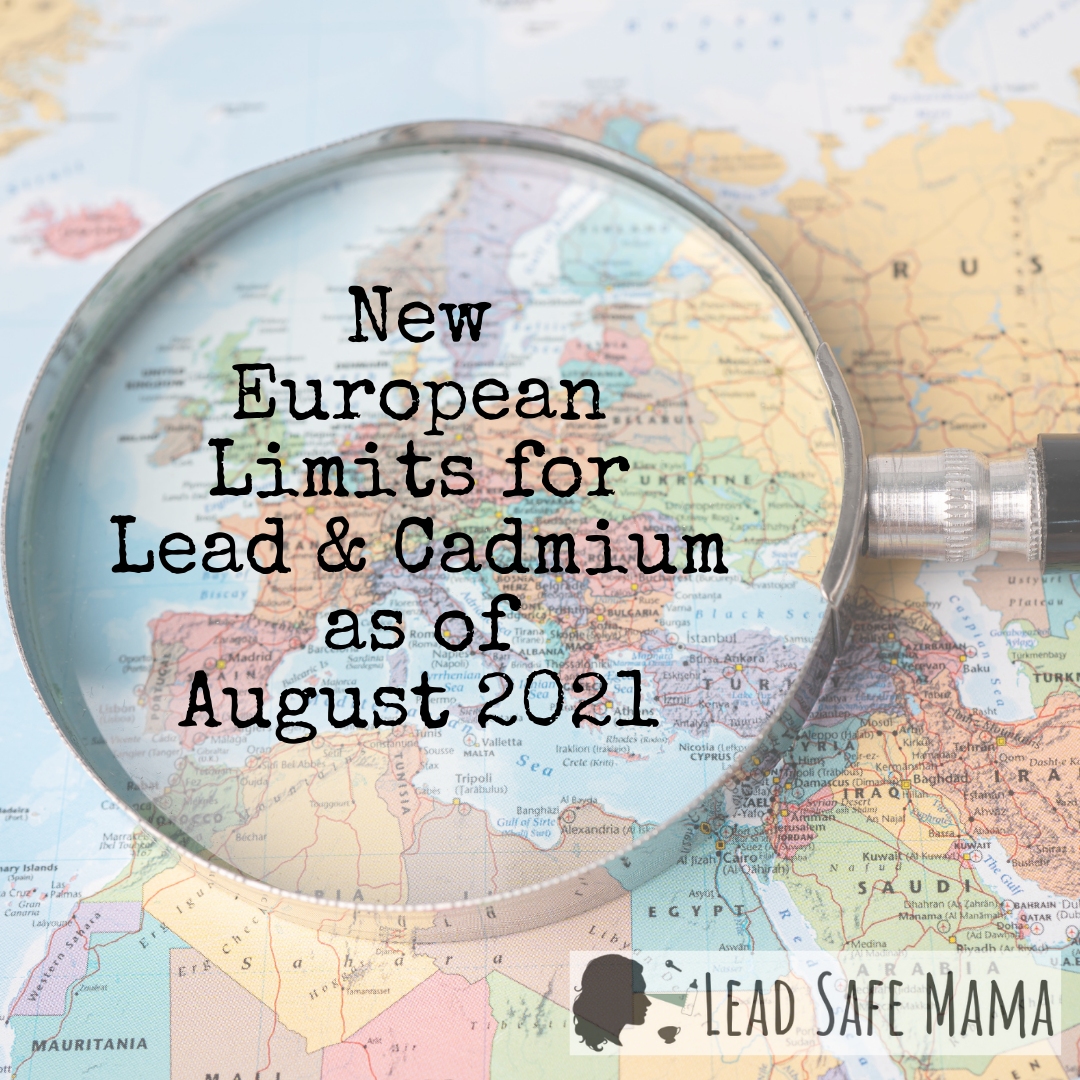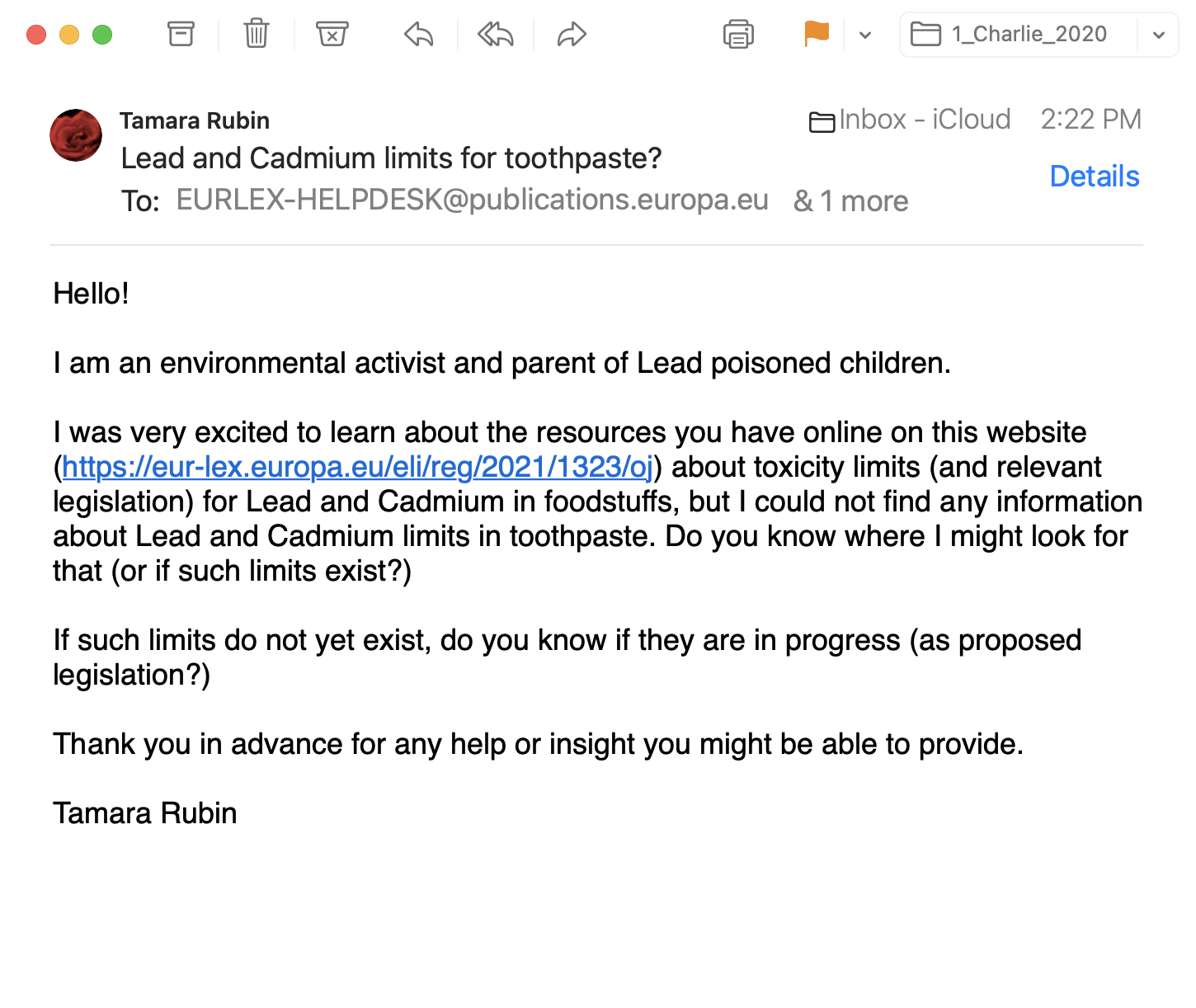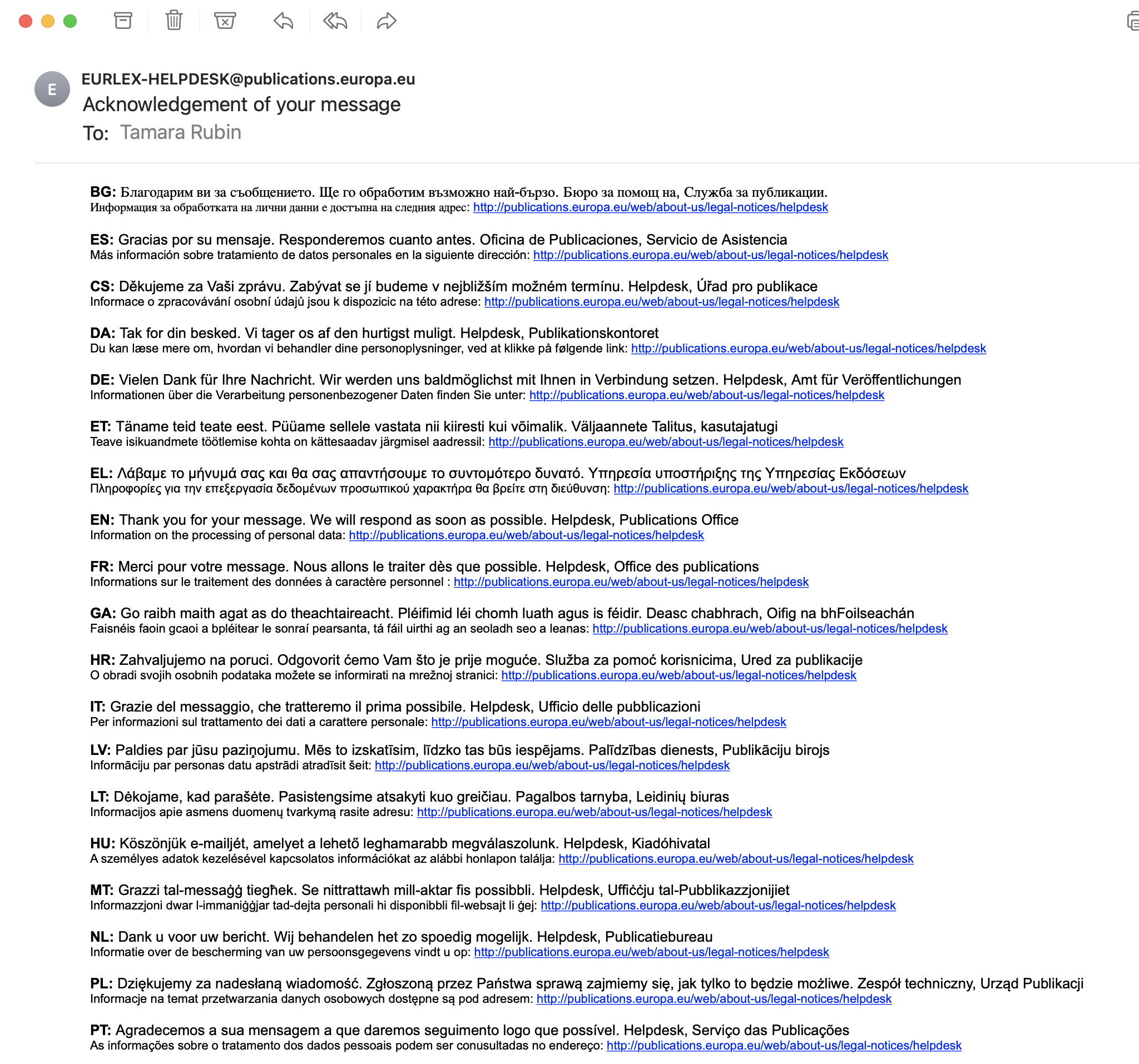From the “Official Journal of the European Union,” here are the new European limits for Lead and Cadmium in “foodstuffs” (including salt & supplements) as of August 2021

For those new to this website:
Tamara Rubin is a multiple-federal-award-winning independent advocate for childhood Lead poisoning prevention and consumer goods safety, and a documentary filmmaker. She is also a mother of Lead-poisoned children (two of her sons were acutely Lead-poisoned in 2005). Since 2009, Tamara has been using XRF technology (a scientific method used by the U.S. Consumer Product Safety Commission) to test consumer goods for toxicants (specifically heavy metals — including Lead, Cadmium, Mercury, Antimony, and Arsenic). All test results reported on this website are science-based, accurate, and replicable. Items are tested multiple times to confirm the test results for each component tested. Tamara’s work was featured in Consumer Reports Magazine in February of 2023 (March 2023 print edition).
Published: July 7, 2022 — Thursday
For easy reference, I have just uploaded PDFs of the two summary pages for the August 2021 European regulations on Lead and Cadmium in “foodstuffs” (aka: “stuff you might put in your mouth or swallow,” including spices, supplements and salt) below. Continue reading below the links for some specific highlights and considerations brought up by these new (stricter) regulatory standards.
- Uploaded PDF for the August 2021 Lead Standards
- Uploaded PDF for the August 2021 Cadmium Standards
- Link to the website where these can be found — in many languages, too! (EUR-Lex, access to European Union law, and an official website of the European Union)
- Link to one summary article that shared this information when it was published (from FoodSafetyNews.com)
Two important quotes from the above linked article (#4):
“In January 2009, a European Food Safety Authority (EFSA) opinion on Cadmium in food concluded it is primarily toxic to the kidneys and may cause renal failure. The agency set a tolerable weekly intake for cadmium of 2.5 μg per kilogram of body weight.”
“In March 2010, an EFSA opinion on Lead in food identified it can cause developmental neurotoxicity in young children and cardiovascular issues in adults. The authority expressed a concern that the levels of dietary exposure to lead might affect neurodevelopment in fetuses, infants, and children.”
Continue reading for some specific highlights and considerations about these August 2021 European limits
Measurement considerations
- The regulatory limits listed in the above-linked reports are noted in mg/kg (read as “milligram per kilogram”).
- Mg/kg, said another way, is parts per million (ppm).
- One part per million (1 ppm) equals 1,000 ppb (parts per billion).
- In general, in the United States, food toxicity is measured in parts per billion. (Billion with a “B.”)
- Here is an article I wrote with a bunch of different conversion examples for context.
- If you need a unit conversion calculator, there are many available online. Here’s one link as an example.
Some of the more important highlights from the limit summaries linked above
LEAD LIMITS of interest
- The new European limit for Lead in most salt is 1,000 parts per billion (1.0 ppm)
- The new European limit for Lead in honey is 100 parts per billion (0.1 ppm)
- The new European limit for Lead in supplements is 3,000 parts per billion (3.0 ppm)
- The new European limits for Lead in wines ranges from 100 to 200 parts per billion (0.1 to 0.2 ppm)
- The new European limits for Lead in fruit juices ranges from 30 to 50 parts billion (0.03 to 0.05 ppm)
- The new European limit for Lead in most fresh fruit is 100 parts per billion (0.1 ppm)
- The new European Medical Foods and Formula limits for children range from 10 to 20 parts per billion (0.01 to 0.02 ppm)
Cadmium LIMITS of interest
- The new European limit for Cadmium in most salt is 500 parts per billion (0.5 ppm)
- The new European limit for Cadmium in most supplements is 1,000 parts per billion (1.0 ppm)
- The new European limit for Cadmium in most powdered baby formula is 10 parts per billion (0.01 ppm)
FYI: How/ why I came across this information in June 2022
While I was aware that new European legislation had been passed, outside of the concerns and European limits for Cadmium in chocolate, since the new limits were published I had not yet referenced it in any of my writing (to provide context for some of the level of Lead and Cadmium that I have found in various products). In June 2022, I was researching/ looking for some background data/ studies to support my assertions that the Lead and Cadmium levels found in Primal Life Organics bentonite clay-based toothpaste were unsafe (I knew from my previous research on bentonite clay contamination the levels found were unsafe, but I wanted to find more peer-reviewed science and regulatory standards to support my statements), and that’s when I came across the information I have linked above.
While all of the highlighted points of note in the bulleted lists above are interesting, I find it ESPECIALLY interesting that the new official European limit for fresh FRUIT for Lead is 100 parts per billion (0.1 ppm). This is particularly pertinent because (across the board, really) the makers of bentonite clay based toothpaste products and other clay-based supplements persistently claim that their products “don’t have any more Lead than one might find in fruit” (which I already knew was BS, based on the extensive testing I have done over the past 13 years, but I was looking for some more official statements on that specific point to support my writing). So these toothpaste powders (and their clay base) are testing positive for levels in the range of 4,000 to 22,000 parts per billion Lead (and — again — the regulatory limit for Lead in fruit is 100 ppb)! Nuff said?
I couldn’t find any specific European limits for Lead or Cadmium in toothpaste, specifically, so I wrote the following email. I will let you all know if I get any sort of response (but check out the automatic response I received right away — below):
Here’s the preliminary automatic response I received — it is actually something like three pages long (so much fun to see an automated response in so many different languages)!

Never Miss an Important Article Again!
Join our Email List











Tamara,
Good work. Note that now the UK has left the EU these revised limits do not apply here. The LEAPP Alliance has written to our secretary of state for food etc. asking for us to match.
What are the equivalent restrictions in the USA?
best wishes,
Tim
thank you Tamara warrior mom !
keep it up !
we need you !Susan in Az / only 114 degrees. and public water supply in dire straights. people ignorantly water lawns and golf courses!
makes me catchy !
Love you all-
Thank you!
https://www.bvna.com/food-agri/services/natural-health-product-testing
You never got a response to your email?
The new European limit for Lead in most salt is 1,000 parts per billion (1.0 ppm)
Your salt testing uses the 2021 proposed action level of 5.0 ppb. I am surprised by the huge difference knowing that European standards are often stricter than US.
Safety Standards for kids, vs. Safety Standards for Adults
What do you think of the limits they have set ? They are for food that both adults and children will be eating, other than the infant formula and many limits are surprisingly high. Cocoa at 800ppb? Initially I looked at the pdfs in hopes that if we bought European chocolate it would be better because it had to have passed the EU limits, but those limits are not very reassuring. What do you think? I am glad there are some limits, it will catch the obscene stuff like lead being intentionally added to turmeric, but otherwise it doesn’t seem super good.
Also, do you know how they are enforcing/checking these limits in food?
Also, what do you think of limits that vary depending on the food. For example they allow more heavy metals in salt harvested over clay beds vs not. It seems to me that it should be the other way around, they find a safe limit for salt and all salt has to meet the limit. At a minimum if it is known that fleur de sel etc has higher levels, it should come with a warning and that industry should be given an amount of time to change their process, not just given a higher limit.
Also, looks to me like the charts can be used as a way of knowing what foods will likely have more or less lead. Like I didn’t know that leafy greens were on the high side or that vegetarians get greater intake of heavy metals (why do you think that is? )
Limit in EU is 2mg/kg ( 2000 ppb ) for unrefined salt :” fleur de sel” and “grey salt” manually harvested